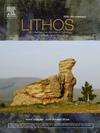安吉科斯深成岩的地球化学、地质年代和构造方面:对博尔博雷马省北部等粒状高K钙碱性岩浆活动的启示
IF 2.9
2区 地球科学
Q2 GEOCHEMISTRY & GEOPHYSICS
引用次数: 0
摘要
本文章由计算机程序翻译,如有差异,请以英文原文为准。
Geochemistry, geochronology, and tectonic aspects of the Angicos plutonism: Insights into equigranular high-K calc-alkaline magmatism in the northern Borborema Province
The Borborema Province is renowned for its prominent Ediacaran to Cambrian plutonism, constituting more than 15 % of its total area. Within this context, the Angicos Batholith is a NNE-trending elongated pluton with ca. 250 km2, representing one of the largest bodies with equigranular texture in the northern part of the province. On the northwestern margin of the batholith, the Poço da Oiticica Stock forms a N-S elongated intrusion, while the NW-SE semicircular Flores Stock is situated on the northeastern side. Both exhibit compositions and textures like those of the batholith. Despite its volume, the understanding of the granitogenesis in this area remains limited due to a lack of comprehensive data concerning geochemistry, geochronology, and geological-geophysical mapping approaches. In this study, we present a new analytical dataset of Angicos Plutonism combined with remote sensing and aerogeophysical data to assist in geological-structural mapping. The equigranular granites are composed of orthoclase (Or96-90Ab4–10), oligoclase (An21-17Ab77-81Or2–1), and Fe-biotite with smaller amounts of magnetite, ilmenite, apatite, allanite, monazite, fluorite, and zircon. These rocks exhibit SiO2 contents ranging from 70 to 75 wt%, total alkalis from 8.8 to 9.0 wt%, and weakly peraluminous compositions. The batholith has enrichment in large ion lithophile elements and depletion in high-field strength elements. The light rare earth elements content is high [4 ≤ (La/Sm)N ≤ 11], combined with negative Eu anomalies (Eu/Eu* = 0.4–0.9) and a fractionated spectra of heavy rare earth elements [4.2 ≤ (Gd/Yb)N ≤ 7.7]. The newly obtained U-Pb age of 584.8 ± 0.9 Ma on the southern side of the body is compatible with the peak of plutonic activity in the northern Borborema Province. The compositional and textural similarity between the Angicos granites and younger neighboring stocks (∼550–530 Ma) highlight a long-lived period of high-K calc-alkaline magmatism in the region, with the Angicos Batholith representing one of the oldest members of this suite. The geochemical signature combined with the presence of xenoliths of banded gneisses along with inherited zircons of the Rhyacian Period, suggests crustal recycling in the region, where metaplutonic rocks of the Caicó Complex would be the main source of granites. The equigranular texture of such a large pluton would be justified by high undercooling rates. In this context, the extensional bridging accommodation mechanism in laterally alternating shear zones emerges as a plausible model for the emplacement of the Angicos Batholith.
求助全文
通过发布文献求助,成功后即可免费获取论文全文。
去求助
来源期刊

Lithos
地学-地球化学与地球物理
CiteScore
6.80
自引率
11.40%
发文量
286
审稿时长
3.5 months
期刊介绍:
Lithos publishes original research papers on the petrology, geochemistry and petrogenesis of igneous and metamorphic rocks. Papers on mineralogy/mineral physics related to petrology and petrogenetic problems are also welcomed.
 求助内容:
求助内容: 应助结果提醒方式:
应助结果提醒方式:


